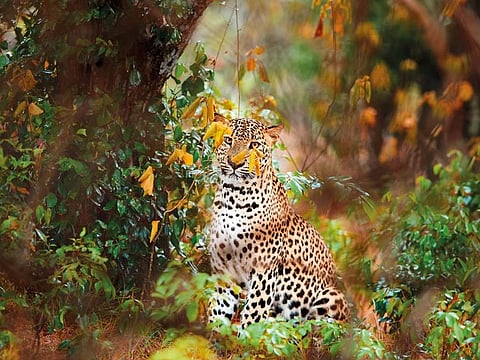Sri Lanka: Tourism with a purpose
Opportunities abound to explore this beautiful country and volunteer

Impact tourism is an emerging movement whereby travellers, businesses, and organisations in partnership with host communities are contributing time, skills, and hands-on work to support social and environmental projects in the destinations visited. Locals benefit by gaining employment, skills training, and often improvements in healthcare and education.
Sri Lanka has many small groups working behind the scenes, one of which is The Hüsk Organisation, formed in 2021 by the UAE-born Chavez Selvaratnam, who returned to live in Sri Lanka to help uplift underprivileged communities.

“It’s a country with so much potential. It offers a fascinating history, rich fertile land, plentiful water and has friendly, engaging people,” he says.
After a visit to Mannar Island off the northwest coast of Sri Lanka during the Coronavirus lockdowns, he was distressed by the poverty among local people. He saw that some were hungry, unemployed and that the few day care centres on the island were very overcrowded. Hüsk Organisation then partnered with the Australian-Sri Lankan NGO Bridging Lanka and the Dutch charity, Little Leaders Foundation, to raise funds to build a preschool.
About 73,000 people of all faiths live in this area that was badly affected by the Sri Lankan Civil War. Although the war ended in 2009, the population continued to suffer with a lack of infrastructure and employment opportunities, youth substance addiction and poor educational facilities.
Little Trees Nurtury Preschool in Puthukkudiyiruppu village will be a world-class early childhood education (ECE) facility, says Jeremy Ahamed Liyanage, Executive Director, Bridging Lanka. A funding of $60,000 is still sought to complete the preschool building but the plan is to finish this June.
“Dr Julie Wren, an early childhood education (ECE) expert from Australia, is assisting us in establishing the preschool with its philosophy and pedagogy positioned at the cutting-edge of global ECE thinking,” he says.

Local teachers are currently being trained and 20 children have enrolled; it will cater to 100 students in the future. There is a playground, an organic garden and nature trails, with children having access to Bridging Lanka’s nearby animal rescue centre and a separately run Donkey Clinic.
Covid and the economic crisis have had a profound effect on children’s learning across the Mannar district, says Liyanage, which led Bridging Lanka to establish a programme for primary and secondary grade children to help them to deal with problems at home, in the street and at school.
Another programme called Fighting Fit encourages young men to kick substance misuse, improve their mental health and become leaders in their community by engaging in a range of physical fitness programmes and workshops.
The Hendro Animal Rescue Centre is another service of the NGO. It runs a sterilisation and vaccination against rabies programme for street dogs and cats, in line with the government’s catch-neuter-vaccinate-release approach.
“Our ultimate goal is a rabies-free Mannar District and a controlled dog population – starting on Mannar Island,” says Liyanage. Volunteers are needed in multiple areas from web design to animal husbandry to drive these projects, he says.
Community-driven travel experiences
For the visitor, Mannar Island features large expanses of white sand, palmyra palm and ancient baobab trees. Attractions include the Talaimannar Lighthouse, Mannar Dutch Fort, historic churches and temples and the Adam’s Bridge Marine National Park which is a hotspot for migratory birds including flamingoes.
Wilpattu National Park featuring leopards and elephants, is about a three-hour drive away.
Many of Sri Lanka’s environmental issues are caused by public unawareness. The Pearl Protectors, a volunteer-based environmental youth organisation formed by Muditha Katuwawala, educates people about the importance of marine ecosystems and the value of the ocean as a resource.

In May 2018 Katuwawala, economist and deep-sea diver, formed the group after coming across a beach where he couldn’t see the sand because of the plastic pollution scattered upon it. He and teams of volunteers have been clearing underwater marine debris and stranded fishing gear from coral reefs ever since.
Turtles get entangled in stranded ghost fishing nets; nylon and polyester based plastic nets are responsible for destroying other sensitive ecosystems and harm crustaceans, fish and seabirds, he says.
Cleaner Seabeds for Sri Lanka is a four-year project initiated by The Pearl Protectors and supported by various stakeholders including a grant from the Lanka Environment Fund. Clean-up dives for the first two stages were conducted in Colombo and Trincomalee and further dives for the third phase will take place in Colombo, Negombo, Batticaloa and Trincomalee, depending on the season.
“We try to maintain a calendar but our activities are very weather dependant,” says Katuwawala. Clean up events are generally posted on The Pearl Protectors’ social media pages where volunteers can register their interest. All dive volunteers, visitors or locals, must have a PADI (Professional Association of Diving Instructors) certification or similar.
Other initiatives requiring volunteers are the turtle patrols, currently being conducted along the western coastline including in Colombo, and will run until March. Once trained, volunteers are out every night from 9pm patrolling the beaches to ensure the safe passage of turtles coming in to lay their eggs. “Poaching is a problem during nesting season,” he says.
And in Colombo Port on Friday, February 16, Greenpeace’s ship the Rainbow Warrior will be collaborating with The Pearl Protectors at a workshop that will discuss key challenges the ocean is facing, focusing on the marine life and habitats of Sri Lankan waters.
It’s a hard question for Katuwawala to answer as to where the best tourist spots are, should volunteers want to sightsee prior to or after their voluntary work, for The Pearl Protectors venture into almost the entire coastline of this island nation.
“There are pockets of paradise everywhere,” he says. ■
Sign up for the Daily Briefing
Get the latest news and updates straight to your inbox



